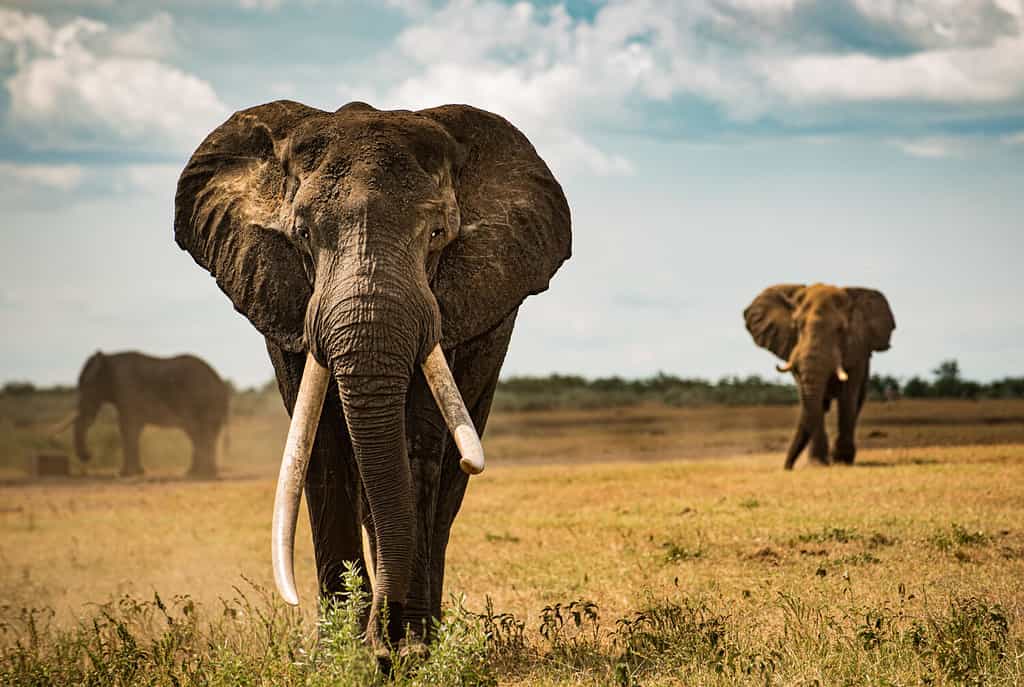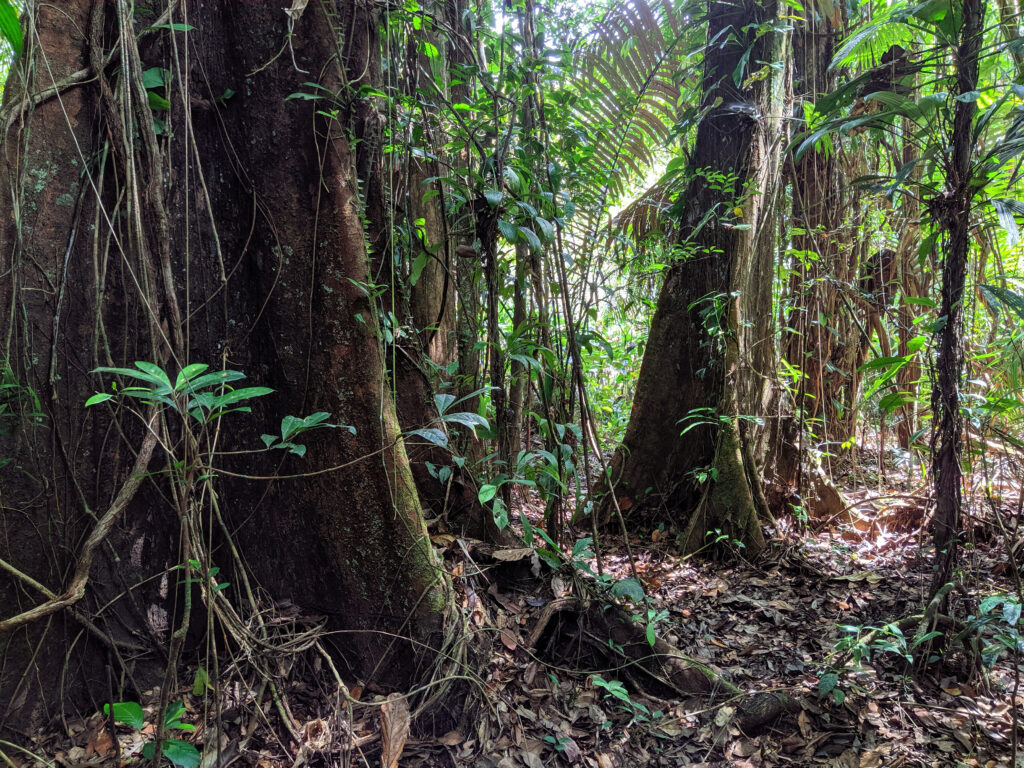Throughout history, remarkable discoveries have captured people’s imaginations. The largest elephant tusk ever found is one such extraordinary find. The find leaves us in awe of the natural world’s wonders.
This colossal artifact is a testament to the might and majesty of these magnificent creatures.
This article will tell you the story of how explorers found a majestic tusk, its size compared to everyday objects, its importance, and where you can see it now..
The Discovery of the Colossal Tusk

The story of the largest elephant tusk ever found begins in the heart of Africa.
©Johann Mader/Shutterstock.com
The story of the largest elephant tusk ever found begins in the heart of Africa. A brave team of researchers and explorers embarked on a daring expedition in the early 20th century.
It was the year 1955. A group of dedicated individuals, driven by a passion for uncovering the Earth’s hidden treasures, set out on an arduous journey through the dense jungles of the Democratic Republic of Congo.
Their mission was clear: to find evidence of the largest land mammals that had ever roamed our planet. They were in search of the African elephants.
Little did they know that they were about to stumble upon a remarkable discovery. This discovery would forever alter our understanding of these magnificent creatures.
The journey led by famous and well-known paleontologist, Dr. Robert Langford, was fraught with challenges. They battled extreme heat, dangerous and uneven terrain, and wildlife encounters that tested their mettle.
It was during one of their treks into the heart of the jungle, deep within the Garamba National Park, that their efforts bore fruit.
A Remarkable Find

Explorers traveled deep into the jungle undergrowth.
©Petr Muckstein/Shutterstock.com
Amidst the dense undergrowth and towering trees, the explorers stumbled upon a colossal ivory treasure. Layers of soil and vegetation hid the tusk from view.
It was the largest elephant tusk ever discovered, a magnificent specimen of nature’s grandeur. The tusk measured a staggering 13 feet in length and weighed an astonishing 226 pounds, eclipsing any previous discoveries.
The tusk’s sheer size was mind-boggling! Try to fathom how such a colossal creature could have once roamed the Earth.
Permit me to put it into perspective for you. This colossal tusk was roughly the length of a small car, dwarfing even the most substantial of human-made objects.
Comparing the Tusk’s Size to Everyday Objects
To truly grasp the immensity of the largest elephant tusk ever found, let’s draw some striking comparisons to everyday objects:
- A Grand Piano: The tusk’s length is roughly equal to the length of a grand piano. Imagine an elephant that once carried this incredible piece of ivory, a living testament to nature’s craftsmanship.
- A Fully-Grown Giraffe: An average adult giraffe stands at around 16 to 18 feet tall. The tusk, at 13 feet in length, would have been as long as three-quarters of a fully-grown giraffe. Just imagine the mammoth proportions of this elephant’s ivory masterpiece.
- A Small Car: As mentioned earlier, the tusk’s size was comparable to that of a small car. Picture an elephant majestically bearing its impressive tusk as it roamed the African Savannah. The sight must have been truly awe-inspiring.
The Significance of this Discovery

Ivory from tusks has been used to make piano keys, dominoes, and even false teeth.
©iStock.com/MagicColors
The finding of the largest elephant tusk ever discovered holds immense importance on multiple fronts:
Scientific Value: This colossal tusk provided invaluable insights into the biology and ecology of prehistoric elephants. Researchers were able to study the growth patterns, diet, and lifestyle of these ancient giants. This also shed light on their role in shaping the ecosystems of the past.
Conservation Awareness: The discovery served as a stark reminder of the devastating impact of poaching on elephant populations. It underscored the urgent need for global conservation efforts to protect these magnificent creatures and their habitats.
Cultural Heritage: The tusk became a symbol of Africa’s rich cultural heritage, a testament to the deep-rooted connection between elephants and the people of the continent. It served as a source of pride and a rallying point for conservation efforts.
Inspiration: The sheer size and beauty of this tusk continue to inspire awe and wonder in people of all ages. The size fosters a sense of appreciation for the natural world and the need to protect it for future generations.
Where Can You Witness this Majestic Tusk Today?
The largest elephant tusk ever found, after its discovery, embarked on a journey of its own. The tusk traveled from the heart of the African jungle to become a celebrated exhibit in one of the world’s most prestigious museums.
Today, you can witness this awe-inspiring artifact at the Smithsonian National Museum of Natural History in Washington, D.C. The tusk’s journey to the Smithsonian was not without its challenges. Preserving and moving such a massive ivory specimen required detailed planning and expertise.
After extensive conservation work to ensure its longevity, the tusk found its new home in the museum’s Hall of Mammals. The display stands as a testament to the incredible diversity and grandeur of Earth’s natural history.
Visitors to the Smithsonian have the unique opportunity to stand in the presence of this ancient giant. To marvel at its sheer size. To contemplate the profound impact it has had on our understanding of the natural world.
The largest elephant tusk ever found is not merely a relic of the past. It is a symbol of the enduring connection between humans and nature, a reminder of the importance of conservation, and a source of inspiration for generations to come.
Its discovery in the heart of Africa, its colossal size compared to everyday objects, its immense importance in the realms of science and culture, and its current home in the Smithsonian National Museum of Natural History make it a true marvel of our world.
As we stand in the presence of this extraordinary artifact, we are reminded of the need to protect and preserve the majestic creatures that once roamed the Earth and the natural wonders they left behind.
The largest elephant tusk ever found is a testament to the splendor of the natural world and a call to action to safeguard it for future generations.
The photo featured at the top of this post is © Aelice/Shutterstock.com
Thank you for reading! Have some feedback for us? Contact the AZ Animals editorial team.







